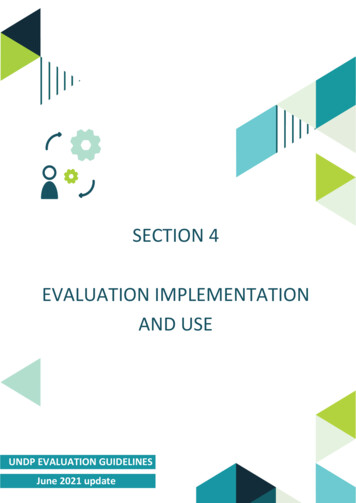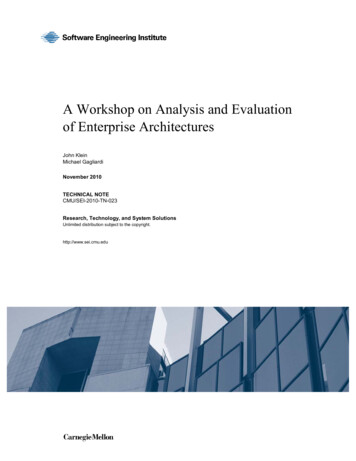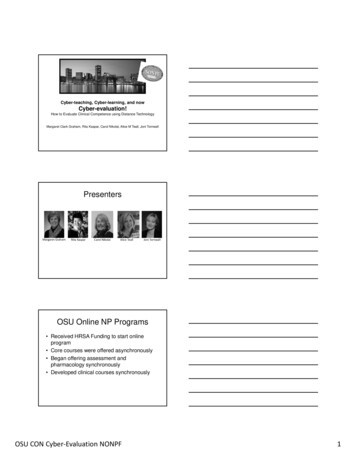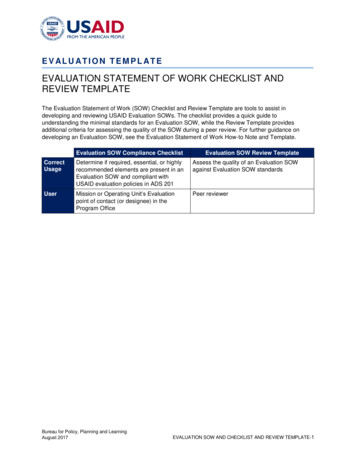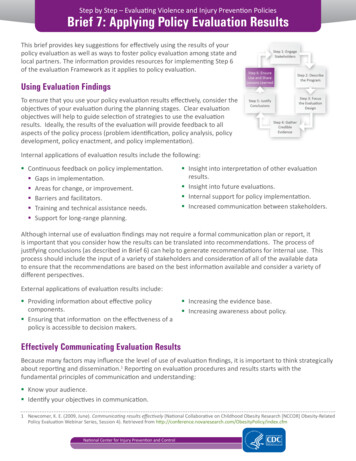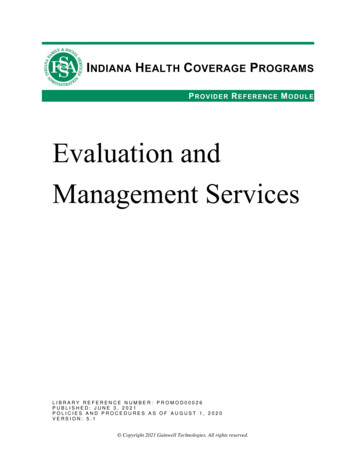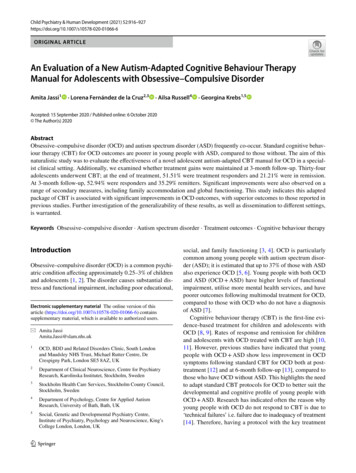
Transcription
Child Psychiatry & Human Development (2021) 66-6ORIGINAL ARTICLEAn Evaluation of a New Autism‑Adapted Cognitive Behaviour TherapyManual for Adolescents with Obsessive–Compulsive DisorderAmita Jassi1· Lorena Fernández de la Cruz2,3· Ailsa Russell4· Georgina Krebs1,5Accepted: 15 September 2020 / Published online: 6 October 2020 The Author(s) 2020AbstractObsessive–compulsive disorder (OCD) and autism spectrum disorder (ASD) frequently co-occur. Standard cognitive behaviour therapy (CBT) for OCD outcomes are poorer in young people with ASD, compared to those without. The aim of thisnaturalistic study was to evaluate the effectiveness of a novel adolescent autism-adapted CBT manual for OCD in a specialist clinical setting. Additionally, we examined whether treatment gains were maintained at 3-month follow-up. Thirty-fouradolescents underwent CBT; at the end of treatment, 51.51% were treatment responders and 21.21% were in remission.At 3-month follow-up, 52.94% were responders and 35.29% remitters. Significant improvements were also observed on arange of secondary measures, including family accommodation and global functioning. This study indicates this adaptedpackage of CBT is associated with significant improvements in OCD outcomes, with superior outcomes to those reported inprevious studies. Further investigation of the generalizability of these results, as well as dissemination to different settings,is warranted.Keywords Obsessive–compulsive disorder · Autism spectrum disorder · Treatment outcomes · Cognitive behaviour therapyIntroductionObsessive–compulsive disorder (OCD) is a common psychiatric condition affecting approximately 0.25–3% of childrenand adolescents [1, 2]. The disorder causes substantial distress and functional impairment, including poor educational,Electronic supplementary material The online version of thisarticle (https ://doi.org/10.1007/s1057 8-020-01066 -6) containssupplementary material, which is available to authorized users.* Amita JassiAmita.Jassi@slam.nhs.uk1OCD, BDD and Related Disorders Clinic, South Londonand Maudsley NHS Trust, Michael Rutter Centre, DeCrespigny Park, London SE5 8AZ, UK2Department of Clinical Neuroscience, Centre for PsychiatryResearch, Karolinska Institutet, Stockholm, Sweden3Stockholm Health Care Services, Stockholm County Council,Stockholm, Sweden4Department of Psychology, Centre for Applied AutismResearch, University of Bath, Bath, UK5Social, Genetic and Developmental Psychiatry Centre,Institute of Psychiatry, Psychology and Neuroscience, King’sCollege London, London, UK13Vol:.(1234567890)social, and family functioning [3, 4]. OCD is particularlycommon among young people with autism spectrum disorder (ASD); it is estimated that up to 37% of those with ASDalso experience OCD [5, 6]. Young people with both OCDand ASD (OCD ASD) have higher levels of functionalimpairment, utilise more mental health services, and havepoorer outcomes following multimodal treatment for OCD,compared to those with OCD who do not have a diagnosisof ASD [7].Cognitive behaviour therapy (CBT) is the first-line evidence-based treatment for children and adolescents withOCD [8, 9]. Rates of response and remission for childrenand adolescents with OCD treated with CBT are high [10,11]. However, previous studies have indicated that youngpeople with OCD ASD show less improvement in OCDsymptoms following standard CBT for OCD both at posttreatment [12] and at 6-month follow-up [13], compared tothose who have OCD without ASD. This highlights the needto adapt standard CBT protocols for OCD to better suit thedevelopmental and cognitive profile of young people withOCD ASD. Research has indicated often the reason whyyoung people with OCD do not respond to CBT is due to‘technical failures’ i.e. failure due to inadequacy of treatment[14]. Therefore, having a protocol with the key treatment
Child Psychiatry & Human Development (2021) 52:916–927ingredients, and an adequate dose of these ingredients, canreduce the likelihood of technical failures.A wide range of modifications have been described in single case reports, including extended treatment, greater useof visual aids, providing support with emotion recognition,incorporating special interests, use of idiosyncratic ratingscales, and increased parental involvement [15–22]. Therehave been a number of randomized controlled trials (RCTs)evaluating CBT for anxiety disorders in young people withASD, which have included some young people with OCD,that have found CBT to be effective for this group [23–25].Whilst OCD has commonalities with other anxiety disorders, it also regarded as being distinct in its presentation[26, 27] and its treatment [28], with a focus on responseprevention as well as exposure to feared stimuli. Therefore,several CBT manuals have been developed specifically forindividuals with OCD ASD which have been evaluatedin two RCTs [29, 30] and a case series [31]. The first RCTfocused on adults (n 33) and a small number of adolescents aged 14 years and above (n 13) with OCD ASD andfound 20 sessions of modified CBT for OCD to be associatedwith a higher response rate than anxiety management [29].The second RCT included only children aged 8–12 years(n 14) and evaluated function-based group CBT targetedat treating obsessive–compulsive behaviours in the broadersense, as opposed to OCD per se [30]. Children randomizedto the CBT group showed a significantly greater reductionin obsessive–compulsive behaviours compared to those inthe treatment as usual group. Finally, the case series focusedon adolescents with OCD ASD aged 11–17 years (n 9)and evaluated an intensive format of CBT for OCD [31].Seven of the nine adolescents responded to treatment, whichinvolved a broad range of 24 to 80 (mean 46.5 20.9) dailyCBT sessions. Although this preliminary evidence is encouraging, these studies were generally small [30, 31], focusedon symptoms rather than an OCD diagnosis [30], usedintensive CBT [31]—which may not be available or feasible to deliver in most clinical settings—or only measuredoutcomes at post-treatment and did not assess maintenanceof gains over time [30, 31].Further, there are a series of questions that remain unanswered. For example, a widely held clinical view is that individuals with co-occurring OCD and ASD tend to requiremore OCD treatment sessions over a longer period of timeto make meaningful gains, compared to those without ASD.Consistent with this, previous research has shown that youngpeople with OCD ASD are engaged with clinical servicesfor significantly longer than those without ASD [7]. However, to date, there is no empirical data to support this view,and it remains unclear whether extending treatment confers an added benefit. This is a crucial question as it hasimportant implications for service delivery and resourceallocation.917The goal of this study was to evaluate a new CBT manualand workbook specifically developed for adolescents withcomorbid OCD and ASD [32, 33] in an open naturalisticstudy, which tend to have higher external validity than typical RCTs [34]. The treatment manual is based on an existingstandard CBT manual for adolescents with OCD [35], butthe content has been modified to suit the profile of youngpeople with ASD and the package of treatment has beenextended from 14 to 20 weekly sessions [32, 33]. Our studyaimed to (i) examine the effectiveness of this new treatmentprotocol on OCD symptoms, family accommodation, andpsychosocial functioning; (ii) establish if the extended treatment duration resulted in additional clinical improvementin OCD symptoms; (iii) assess if the treatment gains weremaintained at 3-month follow-up; and, finally, (iv) investigate the general acceptability of the new treatment approachand seek feedback about the ASD-specific components fromyoung people and their parents. We met these aims by delivering the newly modified treatment manual and workbook toa sample of 34 adolescents with OCD ASD at a specialistclinic.MethodSetting and Study ParticipantsA total of 34 young people with OCD ASD were consecutively recruited to the study from January 2015 toMarch 2018 from referrals to the National and SpecialistOCD, BDD and Related Disorders Clinic, South Londonand Maudsley NHS Trust. The clinic receives referrals fromaround the UK and often young people have had treatment intheir local child and adolescent mental health services beforethe referral to the specialist team is made.Initial assessments consisted of a three-hour evaluationby a multi-disciplinary team (see Nakatani et al. [36] fora detailed description of the assessment process). Comorbid diagnoses (except for ASD) were made based on theDevelopment and Well-Being Assessment (DAWBA) [37].All young people had an established diagnosis of ASDprior to the assessment at the OCD specialist clinic. In themajority of cases (n 23; 67.65%), this ASD diagnosticassessment had involved the Autism Diagnostic Observation Schedule (ADOS) [38] and/or the Autism DiagnosticInterview-Revised (ADI-R) [39]. The remaining 11 youngpeople (32.35%) had been diagnosed with ASD via a clinician assessment without these structured measures. Noyoung people had a diagnosed global learning disability.Participants also completed a series of additional assessment measures (see Measures section).All data used in the current study were collected as partof clinical practice but are of high standard and routinely13
918employed for research purposes [40, 41]. Study approvalwas granted by the South London and Maudsley Child andAdolescent Mental Health Service Audit Committee.MeasuresA series of clinician-reported and self-/parent-reportedmeasures, listed below, were completed. Since effect sizeshave been shown to vary for adapted CBT in people withASD depending on the informant, with smaller effect sizesfor self-report and small to medium for informant and clinicians [42], we considered a range of informants. Measureswere applied at several time-points, including the initialassessment (baseline), session 7, session 14, end of treatment, and 3-month follow-up (unless otherwise specified).Children’s Yale‑Brown Obsessive–Compulsive Scale(CY‑BOCS)The CY-BOCS is a widely used clinician-administeredmeasure of OCD symptoms and severity. It includes a checklist of obsessions and compulsions and a total of 10 itemsassessing the severity of both obsessions and compulsions(i.e., time spent, interference, distress, resistance, and control), with a total score ranging from 0 to 40. The CY-BOCShas shown excellent psychometric properties with high interrater reliability and construct validity [43, 44].Clinical Global Impression Scale—Severity (CGI‑S)and Clinical Global Impression Scale—Improvement (CGI‑I)The CGI-S is a clinician rating of symptom severity; ratings range from 1 (normal, not at all ill) to 7 (among themost extremely ill patients) [45]. The CGI-I is a clinicianrated measure of symptom improvement and is also ratedon a 7-point scale ranging from 1 (very much improved)to 7 (very much worse) [46]. The CGI-S has demonstratedstrong correlations with the CY-BOCS total score (r 0.75)in paediatric OCD research [44]. These scales have beenused in research and clinical contexts [47] and has showngood concurrent validity and sensitivity to change [48].Children’s Global Assessment Scale (CGAS)The CGAS is an adaptation of the Global Assessment Scalefor adults. It is a clinician-rated scale that measures globallevel of functioning in children across different domains.The scale ranges from 1 to 100, with higher scores indicatingbetter functioning. The CGAS has shown good psychometricproperties, including good inter-rater reliability [49, 50].13Child Psychiatry & Human Development (2021) 52:916–927The Children’s Obsessive–Compulsive Inventory (ChOCI)This is a self-report measure assessing severity of OCDsymptoms and has both a parent (ChOCI-P) and a child version (ChOCI-C). ChOCI scores range from 0 to 48, withhigher scores indicating greater severity. The scale includesan obsessions and a compulsions scale, as well as a totalscore. The ChOCI has demonstrated to have good internalconsistency, criterion validity, and convergent validity [51,52].Family Accommodation Scale‑Parent Report Version(FAS‑PR)This is a 13-item parent report questionnaire that measuresthe degree to which family members accommodate theirchild’s OCD symptoms and the level of distress or impairment that they experience as a result [53]. Each item is ratedin a 5-point likert scale ranging from 0 (never) to 4 (daily)and enquires about the last month. The scale includes twosubscales: involvement in compulsions and avoidance oftriggers, as well as a total score [54]. Total scores above 13indicate clinically significant levels of family accommodation. The FAS-PR has demonstrated a stable factor structure,excellent internal consistency, good convergent validity, andadequate discriminant validity [54].The Repetitive Behaviour Questionnaire (RBQ‑2)This is a 20-item parent report measure developed to assessrepetitive behaviours in individuals with ASD, which are acommon feature of the disorder. Response choices, basedon the last month, are combined into three alternatives foreach item (1: never/rarely; 2: mild/occasional; 3: marked/notable). A four-factor model has been proposed as bestfit for the measure, including repetitive motor movements,rigidity/adherence to routine, preoccupations with restrictedpatterns of interest, and unusual sensory interests [55]. TheRBQ-2 has good internal consistency and inter-item validity[55]. This measure was applied at all time-points except forsession 14. Since scores on the RBQ-2 were not expected tochange over time (since the applied OCD treatment does nottarget ASD symptoms), it was not considered an outcomemeasure as such.The Work and Social Adjustment Scale‑Youth Version(WSAS‑Y) and Parent Version (WSAS‑P)This is a self-report measure assessing functional impairment resulting from the presenting condition (i.e., OCD).The original version for adults was developed by Marks[56] and it has been adapted for use in young people andtheir parents [57]. It consists of five items assessing global
Child Psychiatry & Human Development (2021) 52:916–927impairment, with scores ranging from 0 to 40, with higherscores indicating greater functional impairment. The WSASY/P has demonstrated to have excellent internal consistency,adequate test–retest reliability, and good convergent validity[57].Treatment Satisfaction SurveyYoung people and families were given a series of questions(see Supplement) asking how overall satisfied they werewith the received treatment, as well as with specific components of the treatment, including the ASD modifications(e.g., visual materials and worksheets, sessions on understanding ASD and the differences between OCD and ASD,and parental involvement in the sessions). The satisfactionsurvey was only applied at post-treatment.Modified CBT for OCD in Youth with ASDAll participants received individual modified CBT thatincluded as a main component exposure and response prevention (ERP) [32, 33] delivered by experienced clinicalpsychologists, all of whom had a doctoral level of clinicaltraining, who specialised in the treatment of OCD and hadbetween 2–16 years of experience with this patient group.All therapists attended a training workshop delivered byauthor AJ which covered what was included in the adaptedtreatment protocol. Each therapist received weekly supervision from a senior clinical psychologist and was encouragedto bring recordings of sessions for discussion to the supervision sessions. The modified CBT protocol was an adaptation919of a standard CBT protocol for OCD [35]. While the original protocol involves 14 sessions, treatment in this studywas extended to include 20 sessions, which were deliveredweekly. Details of the treatment and specific ASD modifications are outlined in Table 1.All participants progressed through the treatment manualin the same order. The psychoeducation phase of this modified treatment took up to six sessions, whereas in the standard package this typically takes two sessions [35]. Otherbroader ASD modifications of the standard protocol werethe highly structured content of each session, with timingsbeing put on agenda items and being ticked off as sessionprogressed, visual worksheets, and incorporation of specialinterests wherever possible. Scheduled homework each weekwas set to consolidate in-session learning. Parents wereencouraged to attend sessions, either by sitting in for theentire session or joining for a parent check-in at the end ofthe session to hear what was covered and what homeworkwas set. Sessions took place in the clinic, at home, and inenvironments where OCD typically got triggered.Statistical AnalysisMixed-effects regression analyses for repeated measureswith maximum likelihood estimation (MLE) of parameterswere implemented in Stata SE/13.1. Mixed-effects modelsuse all available data, can properly account for correlationbetween repeated measurements on the same subject, havegreater flexibility to model time effects, and can handlemissing data [58]. For each outcome measure, the modelincluded fixed effects of time and subject effects as a randomTable 1 Description of cognitive behaviour therapy for obsessive–compulsive disorder, with autism spectrum disorder modificationsSession contentPsychoeducation on OCD, ASD, and anxietyExternalising OCD, normalising anxiety, reframing anxiety asa protective mechanism (the ‘fight or flight’ response), andOCD hierarchy formationSessions 7–19 Graded ERPYoung people facing increasingly challenging fears on an OCDhierarchySessions 1–6Session 20Relapse preventionReflecting on progress in treatment.Reviewing goals set at the beginning of treatment.Developing a plan of what to do in the event of a set-back.Setting goals for the future.ASD modificationsDifferentiating OCD- and ASD-related repetitive behaviour.Extended psychoeducation on anxiety.Understanding how anxiety differs from other emotions.Development of an idiosyncratic anxiety rating scale.Visual, mini-hierarchies for each step of the main hierarchy toallow young people to take smaller steps during the exposureprocess.Emphasising the similarities between tasks conducted in sessions and for homework to promote generalisation.Off-site visits to conduct ERP tasks to make them ecologicallyvalid.Families leading ERP tasks to allow them to be able to use thetools between sessions and to prepare them for when treatment ends.ASD Autism Spectrum Disorder, ERP Exposure and Response Prevention, OCD Obsessive–Compulsive Disorder13
920intercept factor to account for the variances between participants and within participants.Additionally, percentages of treatment responders andremitters were calculated at the end of the treatment and at3-month follow-up. According to consensus definitions [59],response was defined as a reduction 35% in the CY-BOCSscore and a CGI-I score of 1 or 2, and remission was definedas a score of 12 in the CY-BOCS and a CGI-S of 1 or 2.Alpha (two-tailed) was set at p 0.05 for all analyses. Numbers may vary across analyses as a result of missing values.ResultsDemographic and Baseline Clinical Characteristicsof the SampleDemographic and clinical characteristics of the 34 studyparticipants are summarized in Table 2. Two thirds of thesample were boys (67.64%), the mean age at assessment wasapproximately 15 years (range 11–17), and the mean ageof OCD onset was 11 years. A very large majority (n 31;91%) were on psychotropic medication at the time of the initial assessment. All patients on medication were on selectiveserotonin reuptake inhibitors. Additionally, seven of theseindividuals were on antipsychotics and two were on otherdrugs, namely procyclidine, lithium, and attention-deficit/hyperactivity disorder drugs. Twenty-five (73.52%) had previously undertaken CBT treatment at the time of the initialassessment. Seven (20.58%) participants met diagnostic criteria for at least one other psychiatric disorder, besides OCDand ASD, most commonly an anxiety disorder.Youth in the sample showed moderate to severe symptoms of OCD, as measured with the CY-BOCS, the ChOCIC, and the ChOCI-P. Additionally, they were assessed asmarkedly ill, according to the CGI-S. Mean FAS-PR scoresfell well above the clinical cut-off of 13, indicating clinically significant levels of family accommodation. Participants presented scores in the moderate degree of interference in functioning in all domains, according to the CGAS.This impairment was also reflected in the high scores on theWSAS-Y and WSAS-P.Treatment Outcomes Following CBT for OCDin Youth with ASDYoung people in the study received a mean number of20 sessions (sd 3.07, range 14–30; Fig. 1). Despite thetreatment was protocolised and had a standard durationof 20 sessions, the naturalistic nature of the study andthe fact that patients were receiving this treatment at aregular specialist clinic allowed for a certain degree offlexibility. Five study participants received less than13Child Psychiatry & Human Development (2021) 52:916–927the 20 stipulated sessions (two dropped out of treatmentafter sessions 14 and 15 and three completed treatmentat sessions 17, 18, and 19 due to an improvement of theirsymptoms) and five more received 21, 23, 27, 28, and30 sessions since the corresponding therapist consideredthat further benefit could be obtained from those extrasessions before terminating the treatment.Estimated mean CY-BOCS scores and standard errors(SE) from the mixed-effects model for each time-point areshown in Table 3. The linear mixed-effect regression modelon the CY-BOCS revealed that there was a significant effectof time at all time-points, compared to baseline, indicatingan improvement of the OCD symptoms over time (Table 4and Fig. 2). The estimated reduction from baseline to posttreatment was around 11 points in the CY-BOCS ( 11.14[ 13.07, 9.20]).An additional pairwise comparison between session14 and the end of the treatment showed a notable, statistically significant reduction of the estimate between thesetime-points ( 5.31 [ 7.25, 3.38]), which indicatedthat the addition of extra sessions to the regular 14-sessionprotocol translated into further significant OCD symptomimprovement.In order to assess durability of the CY-BOCS reduction, we ran a pairwise comparison between the end ofthe treatment time-point and the 3-month follow-up timepoint, which resulted in a non-significant estimate (0.01[ 1.95, 1.92], p 0.991), indicating that the OCD symptoms remained stable during the follow-up, after treatmenttermination.Results for the rest of measures for the study participantsare also shown in Tables 3 and 4. The results of the linearmixed-effect regression models for these outcomes showedoverall significant improvements across all measures to boththe end of the treatment and the 3-month follow-up, relative to baseline. Whilst the RBQ-2 was not considered anoutcome measure per se, the total scores and all subscales,with the only exception being Rigidity/Adherence to Routinesubscale, also showed a significant improvement over time.Treatment Response and RemissionThe mean CY-BOCS percentage reduction from baselineto post-treatment was 38%, while the percentage reductionfrom baseline to the 3-month follow-up was 40%. Basedon these reductions and on the CGI-I scores, 17 out of 33participants (51.51% – one excluded due to missing CGI-Sscore) were classified as treatment responders at the endof the treatment and 18 individuals out of 34 participants(52.94%), were responders at the 3-month follow-up. Similarly, based on CY-BOCS and CGI-S scores, seven participants out of 33 (21.21%—one excluded due to missing
Child Psychiatry & Human Development (2021) 52:916–927921Table 2 Baseline demographic and clinical characteristics of the sample of children and adolescents with obsessive–compulsive disorder andcomorbid autism spectrum disorder (n 34)Demographic variablesData availablenFrequency%Sex, boys342367.64–Demographic variablesData availablenMeansdRangeAge at assessment, in yearsAge of onset of the OCD, in years342915.1811.521.702.6811–177–16Clinical variablesData availablenFrequency%On medication at the time of assessmentPrevious cognitive behaviour therapyPsychiatric comorbidity, besides OCD and ASDAnxiety disordersAttention-deficit/hyperactivity disorderBody dysmorphic disorderTourette 65.882.942.94–––––––Psychiatric symptoms measuresData nician-reportedCY-BOCSCGI-SCGASSelf- and parent-reportedCHOCI-C totalCHOCI-C obsessionsCHOCI-C compulsionsCHOCI-P totalCHOCI-P obsessionsCHOCI-P compulsionsFAS-PR totalFAS-PR avoidanceFAS-PR involvementRBQ-2 totalRBQ-2 repetitive motor movementsRBQ-2 rigidity/adherence to routineRBQ-2 preoccupation/restricted patternsRBQ-2 unusual sensory interestsWSAS-YWSAS-PASD Autism Spectrum Disorder, CGAS Children’s Global Assessment Scale, CGI-S Clinical Global Impression—Severity, CHOCI-C Children’sObsessional Compulsive Inventory—Child Version, CHOCI-P Children’s Obsessional Compulsive Inventory—Parent Version, CY-BOCS Children’s Yale-Brown Obsessive Compulsive Scale, FAS Family Accommodation Scale, OCD Obsessive–Compulsive Disorder, RBQ RepetitiveBehaviours Questionnaire, WSAS-P Work and Social Adjustment Scale—Parent Version, WSAS-Y Work and Social Adjustment Scale—YouthVersionCGI-I score) were classified as remitters at the end of thetreatment; this number increased to 12 out of 34 (35.29%)at the 3-month follow-up.Treatment SatisfactionSixteen of the 34 (47.05%) young people and 18 parents(52.94%) responded to the survey. A total of 13 (81.25%)13
922Child Psychiatry & Human Development (2021) 52:916–92705Frequency101520Fig. 1 Histogram for the number of sessions received duringthe treatment by the studyparticipants (n 34)101520Number of Sessions2530Table 3 Model estimates across time-points for each outcome measure from the linear mixed-effects modelsMeasures of psychiatric symptomsCY-BOCSCGASCHOCI-C totalCHOCI-C obsessionsCHOCI-C compulsionsCHOCI-P totalCHOCI-P obsessionsCHOCI-P compulsionsFAS totalFAS avoidanceFAS involvementRBQ-2 totalaRBQ-2 repetitive motor MovementsRBQ-2 rigidity/adherence to RoutineRBQ-2 preoccupation/restricted PatternsRBQ-2 unusual sensory interestsWSAS-YWSAS-PBaselineSession 7Session 14End of treatment3-month 0.592.281.97CGAS children’s global assessment scale, CHOCI-C children’s obsessional compulsive inventory—child version, CHOCI-P children’s obsessional compulsive inventory—parent version, CY-BOCS children’s Yale-brown obsessive compulsive scale, FAS family accommodation scale,RBQ repetitive behaviours questionnaire, WSAS-P work and social adjustment scale—parent version, WSAS-Y work and social adjustmentscale—youth versionaThe RBQ-2 was not applied at session 1413
Child Psychiatry & Human Development (2021) 52:916–927923Table 4 Results of the time effects across time-points for each outcome measure from the linear mixed-effects modelsMeasures of psychiatricsymptomsCoefficient (95% CIs)Baseline to session 7outcomesBaseline to session 14outcomesBaseline to end of thetreatment outcomesBaseline to 3-month followup outcomesCY-BOCS 2.71 ( 4.61, 0.81)**CGASCHOCI-C total2.94 ( 0.56, 6.43) 7.41 ( 12.29, 2.54)** 5.23 ( 8.04, 2.41)*** 1.95 ( 4.33, 0.43) 5.82 ( 7.72, 3.92)***7.40 (3.90, 10.90)*** 5.23 ( 10.91, 0.44) 11.14 ( 13.07, 9.20)***11.66 (8.29, 15.02)*** 13.17 ( 19.04, 7.29)*** 4.22 ( 7.61, 0.84)* 11.16 ( 13.05, 9.25)***12.58 (9.19, 15.97)*** 10.76 ( 16.52, 5.00)*** 5.00 ( 8.32, 1.69)** 5.40 ( 8.24, 2.57)***CHOCI-C obsessionsCHOCI-C compulsions 2.67 ( 5.93, 0.59)CHOCI-P compulsions 7.90 ( 13.19, 2.60)** 5.72 ( 8.60, 2.85)*** 2.32 ( 5.08, 0.44)FAS total 0.96 ( 5.04, 3.12)FAS avoidance 1.41 ( 3.62, 0.80) 6.10 ( 10.69, 1.51)** 4.22 ( 6.71, 1.74)**FAS involvement0.42 ( 1.78, 2.62) 1.89 ( 4.37, 0.58)RBQ-2 totala 5.96 ( 11.19, 0.73)*–RBQ-2 repetitive motorMovementsRBQ-2 rigidity/adherenceto RoutineRBQ-2 preoccupation/restricted PatternsRBQ-2 unusual sensoryinterestsWSAS-YWSAS-P 1.98 ( 3.57, 0.38)*– 5.62 ( 8.50, 2.74)*** 13.42 ( 19.40, 7.44)*** 6.92 ( 10.18, 3.67)*** 6.66 ( 9.78, 3.55)*** 11.00 ( 15.40, 6.61)*** 6.47 ( 8.85, 4.10)*** 4.56 ( 6.93, 2.20)*** 7.93 ( 13.67, 2.20)** 2.99 ( 4.70, 1.29)** 1.17 ( 3.67, 1.34)– 2.65 ( 5.40, 0.09) 1.73 ( 4.64, 1.17) 2.24 ( 3.91, 0.58)**– 2.91 ( 4.73, 1.09)** 2.75 ( 4.68, 0.82)** 1.59 ( 2.62, 0.55)**– 1.50 ( 2.63, 0.37)** 1.61 ( 2.82, 0.41)**0.00 ( 4.09, 4.10) 3.45 ( 7.33, 0.43)0.50 ( 4.12, 5.13) 6.98 ( 11.14, 2.81)** 5.08 ( 9.65, 0.50)* 10.02 (
and workbook specically developed for adolescents with comorbid OCD and ASD [3233, ] in an open naturalistic study, which tend to have higher external validity than typi-cal RCTs [34]. The treatment manual is based on an existing standard CBT manual for adolescents with OCD [35], but the content has been modied to suit the prole of young





